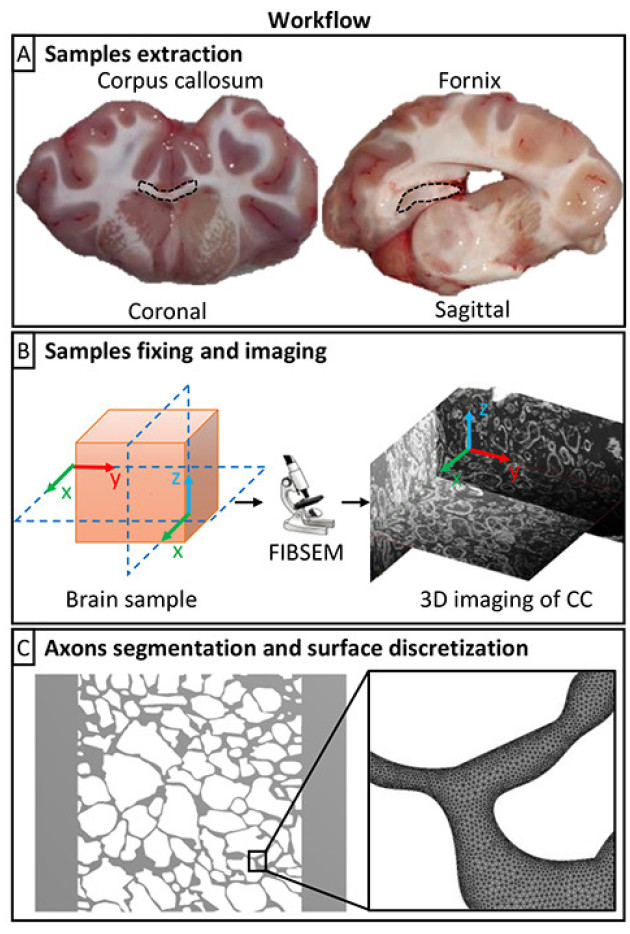
View the seminar recording here (Imperial College members only) or contact k.hobson@imperial.ac.uk to request access.
Centre for Neurotechnology seminar from Daniele Dini
Professor in Tribology, Department of Mechanical Engineering, Imperial College London
The wonders and complexities of brain microstructure: Enabling biomedical engineering studies combining imaging and models
Abstract: Brain microstructure plays a key role in driving the transport of drug molecules directly administered to the brain tissue as in Convection-Enhanced Delivery procedures. This study reports the first systematic attempt to characterize the cytoarchitecture of commissural, long association and projection fiber, namely: the corpus callosum, the fornix and the corona radiata. Ovine samples from three different subjects have been imaged using scanning electron microscope combined with focused ion beam milling. Particular focus has been given to the axons. For each tract, a 3D reconstruction of relatively large volumes (including a significant number of axons) has been performed. Namely, outer axonal ellipticity, outer axonal cross-sectional area and its relative perimeter have been measured. This study [1] provides useful insight into the fibrous organization of the tissue that can be described as composite material presenting elliptical tortuous tubular fibers, leading to a workflow to enable accurate simulations of drug delivery which include well-resolved microstructural features. As a demonstration of the use of these imaging and reconstruction techniques, our research analyses the hydraulic permeability of two white matter (WM) areas (corpus callosum and fornix) whose three-dimensional microstructure was reconstructed starting from the acquisition of the electron microscopy images. Considering that the white matter structure is mainly composed of elongated and parallel axons we computed the permeability along the parallel and perpendicular directions using computational fluid dynamics [2]. The results show a statistically significant difference between parallel and perpendicular permeability, with a ratio about 2 in both the white matter structures analysed, thus demonstrating their anisotropic behaviour. This is in line with the experimental results obtained using perfusion of brain matter [3]. Moreover, we find a significant difference between permeability in corpus callosum and fornix, which suggests that also the white matter heterogeneity should be considered when modelling drug transport in the brain. Our findings, that demonstrate and quantify the anisotropic and heterogeneous character of the white matter, represent a fundamental contribution not only for drug delivery modelling but also for shedding light on the interstitial transport mechanisms in the extracellular space. These and many other discoveries will be discussed during the talk.
- https://www.researchsquare.com/article/rs-686577/v1
- https://www.pnas.org/content/118/36/e2105328118
- https://ieeexplore.ieee.org/abstract/document/9198110

Bio: Professor Daniele Dini is an Engineering and Physical Sciences Research Council (EPSRC) Established Career Fellow and Head of Imperial College London’s Tribology Group. Prior to joining Imperial College in 2006, Professor Dini completed his D.Phil. in the Department of Engineering Science at the University of Oxford (2004). His individual research portfolio supports a large team of researchers focused on studies related to the modelling of surface and interfaces, materials, and various multiscale and multiphysics problems in soft matter and applied mechanics. Most of these projects are multidisciplinary and range from atomic and molecular simulation of friction, lubrication, interfaces and surfaces to the biomechanics of soft tissues, including articular cartilage and brain. Of particular interest for this talk is the work performed by his group and collaborators as part of collaborative EU projects (ACTIVE, http://www.active-fp7.eu/ and EDEN2020, https://www.eden2020.eu/) to shed light on the mechanics of brain and, more specifically, on the behavior of this extremely soft tissue across the scales. The work has explored the link of these investigations to the optimization of convection-enhanced drug delivery procedures to be ideally performed via steerable needles using robotic control.
The seminar will take place via Microsoft Teams. Advance registration is required. A link and instructions on how to access the event are provided in your registration confirmation email and a reminder will be sent before the event.
The seminar/Q&A will run from 1200-1300 and will be followed by an optional 30 minutes’ informal discussion with the speaker.
There is no need to download the Microsoft Teams app if accessing the seminar via desktop or laptop as you can join via a browser, however if using a mobile device, you will need to download the Teams app in advance.